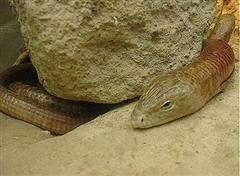Giant Legless Lizard
Glass Lizard, European Giant Legless Lizard, European Glass Lizard Scientific Name: Ophisaurus apodus
Mon, 28th April, 2025 - 1:24 pm GMT
Sponsor Ads:

Alternative Name
Glass Lizard, European Giant Legless Lizard, European Glass Lizard Scientific Name: Ophisaurus apodusBasic Info
A very large lizard and the largest of the family Anguidae, the Giant Legless Lizard averages between two and three feet (.6 to .9 meters) in length and can reach as long as four feet. They usually weigh between 11 and 21 ounces, 300 to 600 grams. The Legless Lizard, as the name would suggest, does not have developed legs and to the naked eye resembles a snake. However, they do have free-floating hipbones and the nubs of underdeveloped leg bones. They also have movable eyelids, belly scales, and the ability to break off their tail - all characteristics snakes do not share. They have powerful jaws and teeth. Within the family Anguidae, there are animals that have fully developed limbs as well as those, like the Giant Legless Lizard, that do not.
Health
Breeding Female Legless Lizards are sexually mature between two and three years of age. An unusual trait among this species is that half of the population are egg layers, and the other half bear live young. For egg layers during the breeding season, which begins in the late spring, females lay anywhere from six to ten soft shelled white eggs in a damp region. During the incubation period, females usually watch over the eggs. The incubation lasts about six weeks. Once the babies are born, the female leaves forcing the young to hunt on their own.Habitat
Found in dry rocky areasBehavior
The largest member of the family Anguidae, the Giant Legless Lizard is a unique and essential member of the animal kingdom. It is also known as the Glass Lizard, European Glass Lizard or European Legless Lizard. Giant Legless Lizards have several unique characteristics, which will be discussed. The Giant Legless Lizard can most often be found in dry rocky areas. They especially enjoy making their homes on rocky hillsides, stone walls, or stone piles. The Giant Legless Lizard seems to be most active after it rains. They are diurnal reptiles, meaning they hunt during the day, though they are also active at others times of the day. They do all of their hunting on the ground. The Giant Legless Lizard enjoys a diet of small mammals, bird eggs, insects, and earthworms. One of the favorite foods of the Giant Legless Lizard is a hard-shelled snail, which their blunt, broad teeth and powerful jaws help them chew.Giant Legless Lizards are essential to the web that is the natural world because they eat pests, which are very destructive to crops. However, because of human predation and capture, the Giant Legless Lizard is considered fairly rare. Another common name for the Giant Legless Lizard is the "Glass Lizard". This name most likely stems from a legend that says that if the Giant Legless Lizard is shaken, it will break into thousands of pieces, like glass, hence the name. While this legend has no basis in fact, it is true that if alarmed, the lizard can shed its tail, which will then break into many pieces. This is primarily a defense mechanism: the pieces of tail continue wiggling and it is very difficult to tell what's lizard and what's tail. For this reason this species should not be handled regularly like some other captive reptiles. The Giant Legless Lizard, although it often reaches an early demise in the wild, can live up to 54 years in captivity.Origin
Europe and AsiaHistory
The European Legless Lizard is found primarily in Eastern Europe, from the Balkans to Northeastern Italy, to Northeast Bulgaria. They can also be found in parts of central and southwest Asia and in the Caucasus mountain range. The Giant Legless Lizard can live as long as 54 years in captivity. However, their lifespan in the wild is much shorter as they are often mistaken for snakes and killed by humans for that reason, or removed from the wild to be kept as pets. People who live in the same regions as the Giant Legless Lizard realize that they play an important role in the economy, and will often protect them from harm. On the Crimean Peninsula, the Legless Lizard is considered a natural treasure. They serve an important role in the ecology, eating insects that often prey on crops. Unfortunately, less well-informed humans are quickly destroying the animal's natural habitat, which in turn destroys the animals themselves. Like other reptiles, the Giant Legless Lizard plays a variety of roles in human life, including keeping the populations of other animals from reaching pest proportions.Common Foods
It has been reported that many wild caught individuals will only eat snails at first. In captivity they seem to do quite well on a diet of small mice, mealworms, and crickets.Sponsor Ads:
There are three types of deliberate falsehoods: lies, damned lies, and salesmen's promises. -- Unknown
Giant Legless Lizard
Coded by: BGID® | ALL RIGHTS RESERVED Copyright © 2000-2025
Disclaimer | Privacy | Report Errors / Contact | Credits








 Preparing For China. China is growing their military. China Military Technology - can it keep up with the US?
Preparing For China. China is growing their military. China Military Technology - can it keep up with the US?  versus
versus 

 versus
versus 
 This Thread is about the North Korean Military itself - the kind of army, navy, and air force they have.
This Thread is about the North Korean Military itself - the kind of army, navy, and air force they have. 
 versus
versus 
 versus
versus  versus
versus